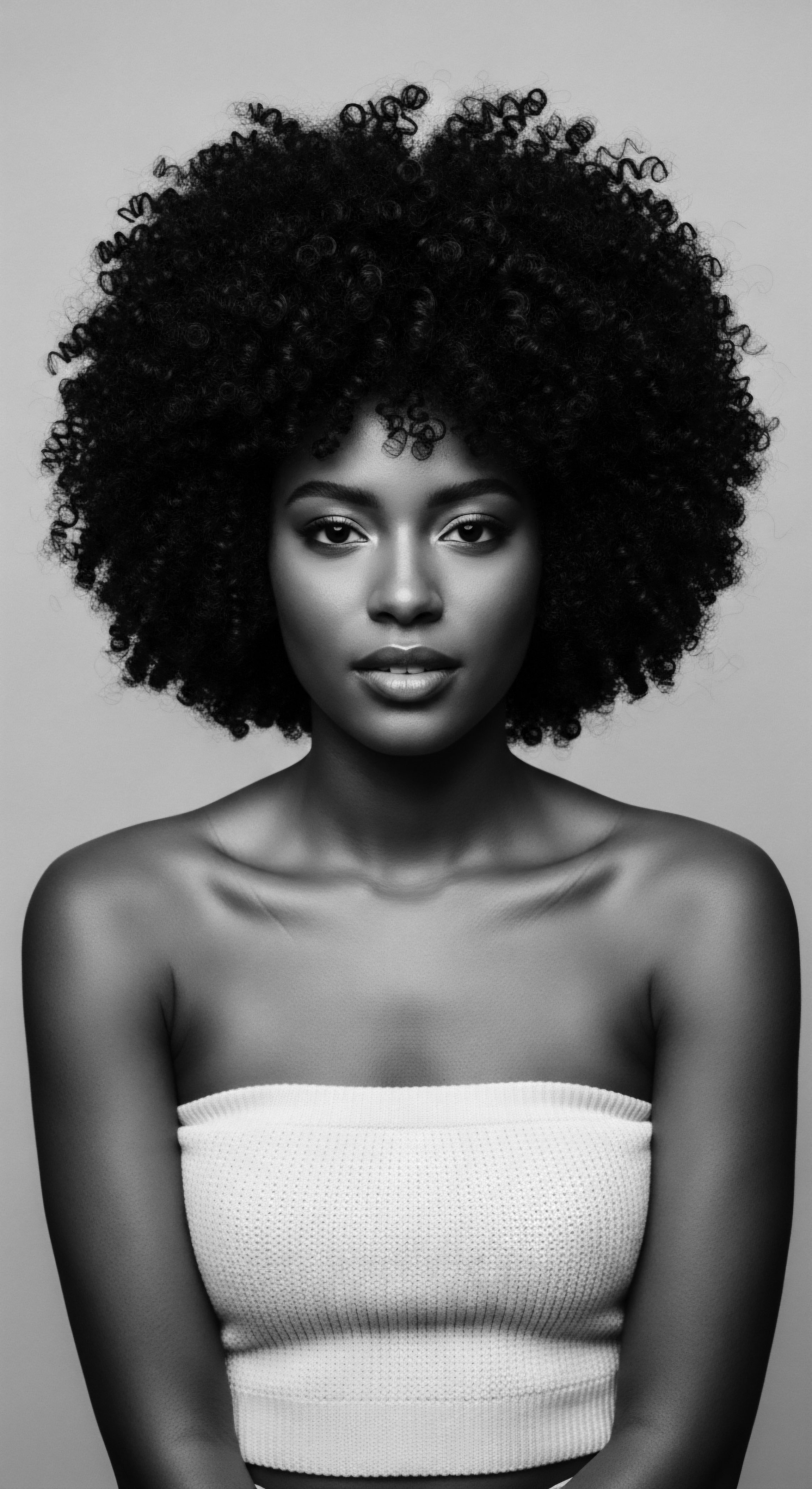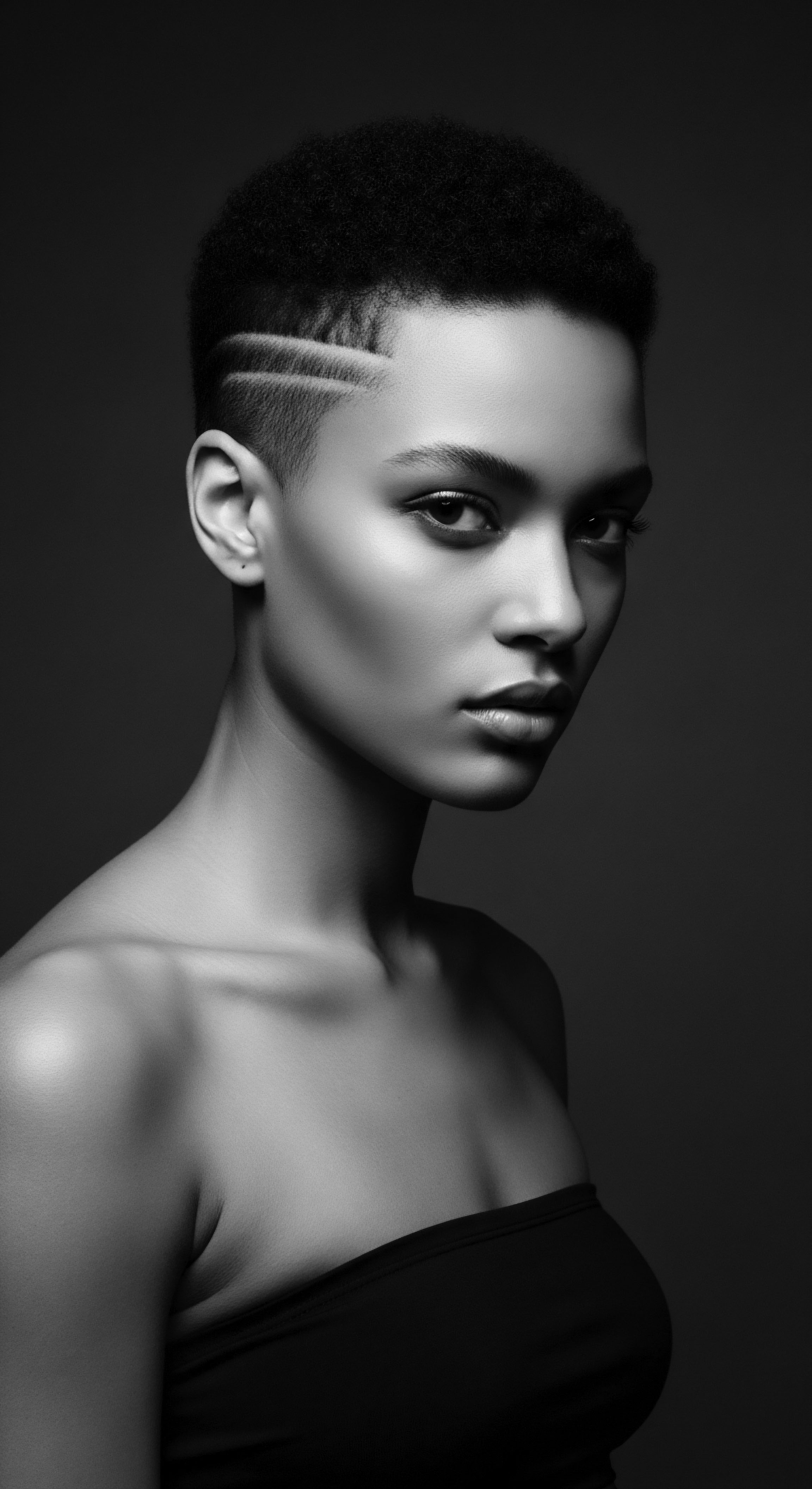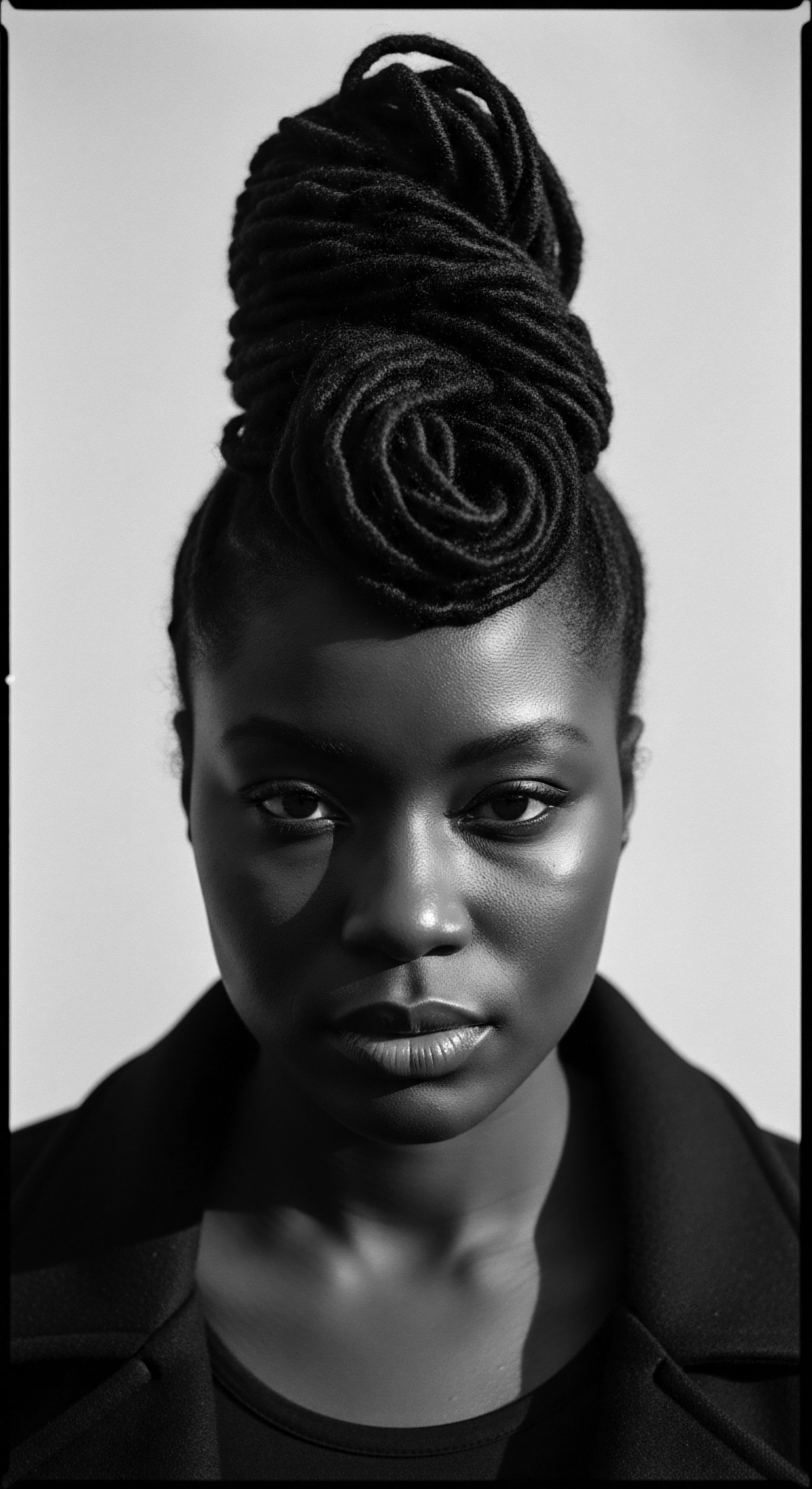
Roots
The whisper of ancestors carries on the wind, a gentle hum through the coils and crowns that adorn generations of Black and mixed-race people. To truly understand why ancestral practices placed such profound emphasis on scalp hydration for textured hair, we must journey back to the genesis of this hair itself—its elemental biology, its intricate architecture, and the environments where it first flourished. This understanding is not merely academic; it is a homecoming, a recognition of inherited wisdom that shaped practices far older than any written record. The hair we wear, in all its glorious variations, holds stories of survival, artistry, and a deep, intuitive connection to the earth’s offerings.
Consider the very structure of textured hair, often elliptically shaped and prone to coiling. This unique morphology, while offering incredible volume and styling versatility, also presents a natural challenge ❉ the journey of natural oils from the scalp down the hair shaft is hindered. For straighter hair strands, sebum—the scalp’s natural moisturizing oil—can descend with relative ease.
For a tightly coiled strand, however, that journey is an arduous one, akin to water trying to run down a spiraling staircase. This inherent structural characteristic means that textured hair, by its very nature, tends towards dryness, making the scalp’s health and hydration paramount.

Hair Anatomy and Ancestral Understanding
The human scalp is a living ecosystem, a delicate foundation from which our hair emerges. Ancestral communities, long before microscopes revealed follicular structures, observed and understood the crucial link between a healthy scalp and thriving hair. They grasped that hair health was intrinsically tied to the condition of the skin beneath it.
A dry, irritated scalp often led to breakage, discomfort, and hindered hair growth. This empirical knowledge guided their practices, leading them to focus on nourishing this living canvas.
The hair follicle, a tiny organ nestled within the scalp, is where each strand of hair is born and nourished. Its activity directly influences the health and strength of the hair as it grows. Ancestral care, whether through direct application of balms or through massage, aimed to support this vital process, ensuring the emerging hair had the best possible start. This wasn’t a superficial concern for aesthetics alone; it was a practical matter of maintaining hair that could withstand the elements, serve cultural purposes, and contribute to overall well-being.
Ancestral hair care rituals were deeply rooted in empirical observation, recognizing the intrinsic link between a well-nourished scalp and flourishing textured hair.

Traditional Classifications and Their Insights
While modern science categorizes textured hair into types like 3A to 4C, ancestral societies possessed their own intricate systems of understanding hair, often tied to lineage, status, and geography. These classifications were less about curl pattern and more about how hair functioned within a particular community’s environment and social structure.
For example, certain communities might distinguish hair based on its resilience to heat or its ability to hold a particular style, indirectly acknowledging moisture retention. The Himbanda Tribe in Namibia, for instance, uses a mixture of clay and cow fat for their hair, which serves to protect it from the sun and aids in detangling, showcasing a profound adaptation to their arid environment and a recognition of the need for protective barriers. This practice speaks to an ancient understanding of external protection as a form of hydration and maintenance, quite separate from our modern concepts of liquid-based moisturizers.
| Ancestral Focus Functionality, resilience, cultural symbolism, environmental adaptation |
| Modern Scientific Focus Curl pattern, porosity, strand density, chemical structure |
| Ancestral Focus Empirical results of ingredients and rituals on hair vitality |
| Modern Scientific Focus Molecular interactions, ingredient efficacy, specific hair shaft properties |
| Ancestral Focus Holistic well-being, spiritual connection, communal ritual |
| Modern Scientific Focus Targeted treatment of specific hair conditions, product development |
| Ancestral Focus The wisdom of old ways, often centered on practical results, finds echoes and explanations within contemporary scientific understanding. |
The languages of these cultures also contained rich lexicons for hair, often describing its states, textures, and the tools used in its care, reflecting a profound attention to its needs. This vocabulary was not divorced from practical application; rather, it codified generations of communal knowledge about how to best tend to hair in diverse climates and for varied purposes.

Ritual
The ancestral impulse to hydrate the scalp was not a fleeting fancy; it was woven into the very fabric of daily life and special occasions, elevated into a practice approaching the sacred. These were not mere acts of grooming; they were rituals, expressions of community, identity, and profound care, passed down through the ages. The methods employed were often deeply integrated with local flora and fauna, reflecting a symbiotic relationship with the natural world that provided the necessary ingredients.

The Sacredness of Scalp Care
Across diverse African societies, hair held immense spiritual and social weight. It was seen as a conduit to the divine, a marker of identity, status, and even one’s life journey. With such significance placed on the hair, the scalp, as its origin point, became a focal point for intentional care. Regular oiling and massaging were not just about moisturizing; they were acts of communion, self-reverence, and indeed, a form of spiritual grounding.
This is echoed in ancient Ayurvedic traditions, where scalp oiling, or Shiro Abhyanga, is revered not just for cosmetic benefits but for balancing body energies and relieving stress. This parallel in ancient wisdom speaks to a universal human understanding of the scalp’s connection to overall vitality.
The communal aspects of hair care were central. Mothers would oil and braid their children’s hair; sisters would tend to one another’s scalps. These were moments of bonding, storytelling, and the transmission of knowledge.
The rhythmic application of oils, the gentle pressure of fingers on the scalp, the shared laughter or quiet contemplation—all contributed to the profound intimacy and importance of these routines. This made scalp hydration a communal responsibility, a shared act of love and preservation of lineage.

Traditional Ingredients and Preparations
The ancestral pharmacopeia for scalp hydration was as vast and varied as the landscapes from which it emerged. These communities utilized what was readily available, transforming natural resources into potent elixirs. The efficacy of these traditional preparations was not a matter of chance; it was the result of generations of experimentation, observation, and refinement.
- Shea Butter ❉ Derived from the nuts of the shea tree, abundant in West Africa, shea butter was a cornerstone of scalp and hair care. Its rich emollient properties made it exceptional for sealing in moisture, protecting hair from harsh environmental conditions, and soothing irritated skin. It is still used widely today for these very reasons.
- Castor Oil ❉ Widely employed in Ancient Egypt and throughout African traditions, castor oil was prized for its thickening and strengthening properties, and its ability to nourish the scalp. Its density allowed it to cling to the scalp and hair, providing lasting hydration.
- Coconut Oil ❉ A staple in many coastal African and diasporic communities, coconut oil provided deep conditioning and was understood to strengthen the hair. Its ability to penetrate the hair shaft made it a favorite for both scalp health and hair resilience.
- Botanical Infusions ❉ Herbs like Amla (Indian gooseberry), Bhringraj, and Neem from Ayurvedic practices, or indigenous plants like Yucca Root, Sage, and Cedarwood Oil from Native American traditions, were often infused into oils or used as rinses to cleanse, soothe, and promote scalp health. These botanical additions offered antiseptic, anti-inflammatory, and stimulating properties, supporting an optimal scalp environment.
These natural ingredients, often gathered and prepared by women, were processed through age-old techniques ❉ crushing, pressing, simmering, and infusing. The result was not just a product, but a tangible link to the land and the wisdom of those who came before.
The communal act of hair care, using natural ingredients like shea butter and castor oil, elevated scalp hydration beyond a mere routine to a significant cultural ritual.

Styling as a Protective Act
The relationship between scalp hydration and traditional styling practices was symbiotic. Many ancestral hairstyles, particularly braids, twists, and locs, inherently served as protective mechanisms. These styles minimized manipulation, reduced exposure to harsh elements like sun and dust, and helped to retain moisture that had been applied to the scalp and hair.
For instance, the intricate Cornrows, dating back thousands of years in Africa, or the elaborate Bantu Knots, were not only aesthetic expressions but also practical solutions for maintaining hair health over extended periods. Before these styles were created, the scalp would often be oiled and massaged, preparing the foundation and ensuring moisture was locked in at the root. This deliberate layering of hydration and protective styling speaks to a sophisticated understanding of hair needs.
The focus was on preservation and longevity, not just transient beauty. This approach stands in stark contrast to many modern practices that prioritize styling over underlying hair and scalp health. The ancestral emphasis on scalp hydration ensured that even within protective styles, the hair’s very source was continuously supported.
| Traditional Styling Practice Braids, Twists, Locs |
| Scalp Hydration Connection Applied oils and butters sealed in; reduced daily friction and exposure. |
| Traditional Styling Practice Clay/Ochre Pastes (e.g. Himba) |
| Scalp Hydration Connection Formed a protective barrier against sun and dryness, indirectly aiding moisture retention. |
| Traditional Styling Practice African Threading |
| Scalp Hydration Connection Allowed for hair stretching with minimal tension, aiding in moisture distribution and length retention after hydration. |
| Traditional Styling Practice Ancestral styling practices were ingeniously designed to both adorn and preserve, with scalp health as a fundamental consideration. |

Relay
The ancestral commitment to scalp hydration for textured hair represents a profound, intergenerational scientific endeavor—a collective understanding of the body’s subtle workings, refined over centuries without the aid of laboratories. This knowledge, passed down through observation, practice, and oral tradition, forms a vital component of our shared heritage, influencing contemporary wellness discourse and illuminating the inherent wisdom in age-old customs. The rationale for emphasizing scalp hydration is multifaceted, encompassing environmental adaptation, biological necessity, and cultural meaning, all intricately intertwined.

Environmental Adaptation and Biological Imperative
Consider the geographic origins of much textured hair, often from arid and semi-arid regions of Africa. In such climates, the harsh sun, dry air, and dust constantly challenge moisture retention for both skin and hair. Textured hair, with its unique structural characteristics—the elliptical cross-section and the coily pattern—means that sebum, the scalp’s natural oil, struggles to travel down the hair shaft to adequately coat and protect each strand. This inherent dryness makes the scalp particularly vulnerable to flaking, irritation, and discomfort.
Ancestral practices intuitively addressed this biological reality. The application of oils and butters directly to the scalp was a direct countermeasure against environmental desiccation. These emollients acted as a protective barrier, locking in the scalp’s natural moisture and providing external lubrication to the emerging hair shaft.
This protective layer also helped shield the scalp from UV radiation and environmental pollutants, preventing inflammation and promoting a more conducive environment for healthy hair growth. The regular cleansing and massage accompanying these applications further stimulated blood flow, delivering vital nutrients to the hair follicles.

Cultural Significance Beyond Biology
Beyond the purely physiological, scalp hydration practices were deeply embedded in the cultural tapestry of Black and mixed-race communities. Hair, as a visible and malleable aspect of self, served as a powerful medium for identity, status, and communication. In many pre-colonial African societies, hair styles could signify marital status, age, ethnic identity, wealth, and social rank. Maintaining healthy, lustrous hair was not merely about beauty; it was a visible affirmation of one’s well-being, community connection, and respect for tradition.
The very act of scalp oiling often transpired within communal settings, transforming a personal grooming task into a shared experience. These were moments for women to connect, share stories, and transmit knowledge from elder to youth. This social function reinforces the communal and relational dimensions of hair care, where tending to one’s scalp was an act of care not just for oneself, but also for one’s familial and societal lineage. The importance of hair in these cultures meant that any practice that sustained its health and appearance was elevated in significance.
Ancestral emphasis on scalp hydration intertwines biological necessity, driven by textured hair’s structure and arid environments, with profound cultural expressions of identity and communal care.

How Did They Acquire This Knowledge?
The understanding of scalp hydration’s importance was accumulated through generations of empirical observation and refinement. Ancestors were keen observers of their bodies and their environment. They noted that certain plants and animal products, when applied to the scalp, alleviated dryness, reduced breakage, and improved the appearance of hair. This was a process of trial and error, a lived science passed down orally and through direct demonstration.
For instance, the use of Chebe Powder by Basara Arab women in Chad is a compelling example. Living in an extremely dry and hot climate, these women discovered that chebe powder, a mixture of herbs, helps to retain moisture, protect hair strands, and prevent breakage, allowing them to grow their hair to significant lengths. This traditional preparation and application method, perfected over decades, demonstrates an acute understanding of how to combat environmental stressors to maintain hair health from the scalp outwards. Their practice of using chebe powder, which forms a seal around the hair, effectively mimics a modern understanding of moisturizing and sealing, directly addressing the challenge of moisture loss in coiled hair.
This knowledge was not static; it adapted as communities migrated, encountered new environments, or integrated new resources. The practices evolved, but the core principle of maintaining a healthy, hydrated scalp remained constant, a testament to its fundamental efficacy. The collective memory of these practices, ingrained in daily rituals and social norms, ensured their preservation and continuation, even in the face of immense disruption, such as the transatlantic slave trade which forcibly severed access to traditional tools and ingredients.

The Echo in Modern Science
Modern trichology and dermatology now provide scientific validation for many of these ancestral practices. We understand that a healthy scalp biome is crucial for hair growth, free from inflammation, dryness, and bacterial imbalances. Contemporary research confirms the occlusive properties of many traditional oils and butters, affirming their ability to create a barrier that minimizes transepidermal water loss from the scalp and keeps hair moisturized. The practice of massaging the scalp, a common accompaniment to oiling, is now recognized for its ability to increase blood circulation to the follicles, potentially aiding nutrient delivery.
For example, studies indicate that certain oils, such as coconut oil, can penetrate the hair shaft, reducing protein loss and strengthening strands from within. This scientific backing for traditional ingredients like coconut oil underscores the profound intuitive knowledge held by ancestral practitioners. The ancestral emphasis on scalp hydration was not just a belief; it was a practical, observable solution to the unique biological and environmental challenges faced by textured hair, imbued with cultural reverence. It is a powerful reminder that wellness wisdom often predates scientific articulation, its efficacy proven through centuries of human experience.
- Moisture Retention ❉ Tightly coiled hair structures impede the natural distribution of sebum along the hair shaft, making textured hair inherently prone to dryness. Ancestral practices directly counteracted this by applying external emollients.
- Scalp Health ❉ A hydrated scalp is a healthy scalp. Ancestors observed that a well-moisturized scalp was less prone to irritation, flaking, and issues that could hinder hair growth or cause discomfort.
- Environmental Protection ❉ Oils and butters formed a protective shield against harsh elements like sun, wind, and dust, preserving the integrity of the scalp and hair in diverse climates.

Reflection
The journey through ancestral scalp hydration practices for textured hair reveals a profound truth ❉ our hair is a living archive, holding centuries of wisdom within its very structure and the traditions that shaped its care. It speaks of resilience, of a deep attunement to nature’s rhythms, and of the enduring human need for connection—to self, to community, and to the earth. The ancestral emphasis on tending the scalp was never a trivial act. It was an essential dialogue between body and environment, a testament to ingenuity, and a quiet rebellion against conditions that might otherwise diminish spirit and vitality.
Roothea’s ‘Soul of a Strand’ ethos finds its very heart in this legacy. Every drop of oil applied, every massage performed, every braided coil meticulously crafted carried not only practical benefit but also the weight of cultural meaning, the whispers of kinship, and the assertion of identity. These practices, born of necessity and elevated through ritual, remind us that true wellness transcends the superficial. It is an acknowledgment of our deepest roots, a celebration of what has been passed down, and a conscious act of perpetuating a vibrant heritage.
As we navigate contemporary landscapes, filled with new products and scientific insights, the wisdom of ancestral scalp hydration serves as a guiding light. It beckons us to slow down, to listen to our hair, and to honor the foundational care that nurtured generations. The enduring significance of scalp hydration is not just about biology; it is about memory, about reclaiming narratives of beauty and resilience that were never lost, merely sometimes obscured. To hydrate the scalp of textured hair today is to continue a conversation with our ancestors, ensuring that the soul of each strand continues its luminous, unbound journey.

References
- Byrd, Ayana, and Lori Tharps. Hair Story ❉ Untangling the Roots of Black Hair in America. St. Martin’s Press, 2014.
- Gallagher, Dan, et al. The Archaeology of Shea Butter. The Journal of Ethnobiology, 2023.
- Hargro, S. K. A Cultural History of Hair in America. 2011.
- Loussouarn, Genevieve, et al. Afro-textured Hair ❉ A Study of Its Unique Characteristics and Needs. International Journal of Cosmetic Science, 2013.
- Randle, M. Hair ❉ A Cultural History. 2015.
- Sherrow, Victoria. Encyclopedia of Hair ❉ A Cultural History. Greenwood Press, 2006.
- Sieber, Roy, and Roslyn Adele Walker. African Art in the Cycle of Life. Smithsonian Institution Press, 2000.
- Thomas, Lori S. The Politics of Hair ❉ Hair Styling, Cosmetic Advertising, and the Culture of Identity in Black Women. Routledge, 2013.
